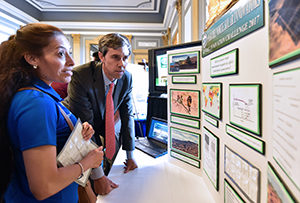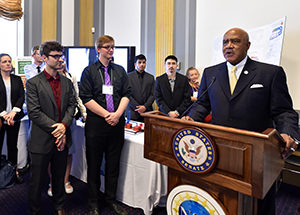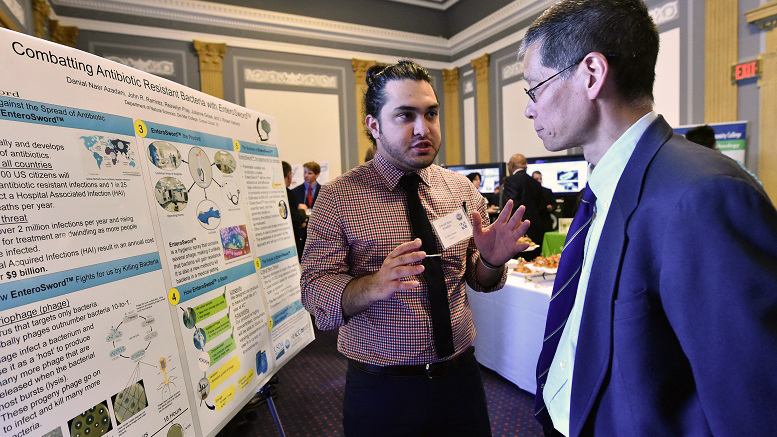Danial Nasr Azadani is passionate about his work. The work? Saving lives.
Azadani is part of a team of students from Del Mar College in Texas that developed a spray that slows the spread of antibiotic-resistant bacteria. About 23,000 people in the United States die each year as a result of bacterial infections.
“We can easily prevent this,” Azadani said.
The Del Mar team’s product – EnteroSword – is “ready to destroy,” Azadani said, excitement in his eyes. “EnteroSword is our future.”
Azadani and the team were one of 10 teams of community college students named as finalists for the Community College Innovation Challenge (CCIC), an annual competition sponsored by the American Association of Community Colleges (AACC) and the National Science Foundation. CCIC asks student teams to develop a STEM-based solution to a real-world problem. This year’s categories were Maker to Manufacturer, Energy and Environment, and Security Technologies.
The finalist teams participated in a bootcamp this week in Washington, D.C., and pitched their projects to a group of judges. They also had the opportunity to display their projects – and their knowledge – to some members of Congress at a reception on Capitol Hill. (Editor’s note: On Thursday evening, Del Mar College was named the first-place winner; Red Rocks Community College in Colorado received second place.)
Azadani, who is simulataneously attending Texas A&M University, is thrilled with the opportunity to show off what he’s been able to learn and do at Del Mar.
“The opportunities and resources at Del Mar are mind-blowing,” Azadani said. “We’re doing graduate-level research.”
His teammate John Ramirez is equally as excited with the opportunities he’s had at the community college. He’s previously worked at psychiatric hospital before deciding to go back to school. His first class at Del Mar was a research course and “it’s been a rollercoaster ride from there,” Ramirez said.
“I can’t get enough of research,” he added. Which is probably a good thing, since the team went through a lot of trial and error before coming up with their product. Ramirez, who hopes to attend medical school, said it wasn’t uncommon to get messages about new ideas from his teammates at 2:00 a.m. But that was part of the fun.
Innovations like this will help to grow the nation’s economy, Rep. Brad Schneider (D-IL) remarked at the Capitol Hill reception.
“It starts with science,” Schneider said.
Tiny house, big difference
Azadani and Ramirez weren’t outliers. All the students on finalist teams were just as passionate about their projects.

Students from El Paso Community College pitch their project at the CCIC exhibit on Capitol Hill. (Photo: NSF)
There are the students at New York’s Corning Community College who are turning recycled plastics into water filters. Any reception attendee holding a bottle of water got stopped by the Corning team to hear what could happen to their bottle. And Team FringeHead from Bucks County Community College (Pennsylvania) whose Simply Secure project can keep confidential materials secure. El Paso Community College in Texas and Forsyth Technical Community College in North Carolina are improving on current solar technologies.
The team from California’s Laney College is working to overturn homelessness with the Pocket House.
Laney College has made a name for itself building tiny houses. The City of Oakland approached the college about building houses for the homeless population.
The city has the land set aside – they just need the houses.
But there were challenges, explained team member Richard Rothbart. The time, money and resources needed to build so many homes were prohibitive. The students didn’t give up, though – they searched for a solution and found it. Instead of making a traditional tiny house, the team is using advanced manufacturing techniques, such as computer numerical control (CNC) routing and prototyping to fabricate an affordable, mobile shelter that can be mass produced and assembled quickly.
The technique means they can make 100 houses in a year for a tenth of the cost of a regular tiny house.
Rothbart had worked at homeless shelters most of his adult life. He said he’s never seen a city take this sort of pro-active approach to helping the homeless.
“It’s inspiring,” said Rothbart, who has a bachelor’s degree in sociology, but returned to college because he “wanted to use my hands.” With the Pocket House project, he’s able to combine his desire to help others with his passion for creating things.
Engineering solutions
At Henry Ford College in Michigan, finding an alternative biofuel meant looking in the backyard. The team used yard waste – of which there’s an abundance – to create Veteroil, which can be used as a substitute for fossil fuels.
“We’re utilizing an untapped resource,” team member Breanna Allen said.
For Allen, this project gave her an opportunity to “think like a real engineer.” She wants to pursue mechanical engineering, but had struggled with “not implementing my skill.”
“I was able to take something outside the classroom,” Allen said.
The team from Red Rocks Community College in Colorado created a cyber lab learning environment to expand their real-world skills. They didn’t just boost their technology skills – they gained “soft” skills, such as the ability to collaborate and think critically.
“Students have to work together to reach a common goal,” Bruno Salvatico said.
Salvatico worked in customer service and retail management before enrolling at Red Rocks Community College.
“Technology is my passion,” he said.
His teammates feel the same way. John Sanchez wanted a career change after owning a moving business. With what he’s learned at Red Rocks, he’s now got a job offer at Northrop Grumman. And Isaac Kerley, a former homeschool student, enrolled at Red Rocks when he was 16. He’s always had an interest in computers and programming, and thinks of his team’s CCIC project as a “sandbox,” giving him a safe environment for advanced learning.
A game changer
There are a lot of other stories of students setting out to change the world.
Oakton Community College (Illinois) students have developed novel ethanol removal technology that will decrease the ethanol pollution that comes from bakeries.

AACC President Walter Bumphus offers a few comments at the CCIC reception and exhibit Wednesday on Capitol Hill. (Photo: NSF)
And the students at Frederick Community College (Maryland) are generating power through mud. They hope to market their innovation to the military.
“It’s an energy backup for when things go wrong,” Sean Scott said.
Scott has graduated, but wants to continue working on the project, as do his teammates, who are finding success outside of college. Godfrey Sseyonga has an internship with Johns Hopkins. Tanner Ash has a job at a biotech firm, and Cassie Kraham has two job interviews lined up.
During remarks at the Capitol Hill event, AACC President and CEO Walter Bumphus said community colleges offer a “game-changer possibility.” With the hands-on research happening, community colleges are proving to be a game-changer for both students and the nation.

